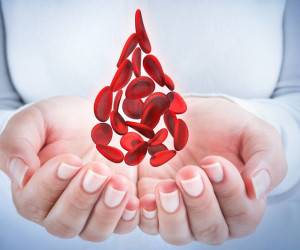
Hemolytic anemia is a disorder in which that red blood cells are destroyed faster than they can be made. The destruction of red blood cells is called hemolysis.
Red blood cells carry oxygen to all parts of the body. If the amount of red blood cells is would be lower than normal, that’s anemia. When someone have anemia, their blood cannot bring enough oxygen to all tissues and organs. Without enough oxygen, the body cannot work as well as it should be.
Hemolytic anemia can be inherited or acquired:
Inherited hemolytic anemia happens when parents pass the gene for the condition on to their children.
Acquired hemolytic anemia is not something to be born with. body develops the condition later.
What causes hemolytic anemia
There are 2 main types of hemolytic anemia: inherited and acquired. Different diseases, conditions, or factors can cause each type:
Inherited
With the inherited type, parents pass the genes for the condition on to their children. Two common causes of this type of anemia are sickle cell anemia and thalassemia. These conditions produce red blood cells that don’t live as long as normal red blood cells.
Acquired
With this type of anemia, patient was not born with in a certain condition. Their body makes normal red blood cells, but they are later destroyed. This may happen because of:
-
Certain infections, which may be viral or bacterial
-
Medicines, such as penicillin, antimalarial medicines, sulfa medicines, or acetaminophen
-
Blood cancers
-
Autoimmune disorders, such as lupus, rheumatoid arthritis, or ulcerative colitis
-
Certain tumors
-
An overactive spleen (hypersplenism)
-
Mechanical heart valves that may damage red blood cells as they leave the heart
-
A severe reaction to a blood transfusion
Some types of acquired hemolytic anemia are short-term (temporary) and go away over several months. Other types can become lifelong persist for a longtime (chronic). They may go away and come back again over time.
symptoms of hemolytic anemia
Each person’s symptoms may vary. Symptoms may include:
-
Abnormal paleness or lack of color of the in skin
-
Yellowish skin, eyes, and mouth (jaundice)
-
Dark-colored urine
-
Fever
-
Weakness
-
Dizziness
-
Confusion
-
Can’t handle physical activity
-
Enlarged spleen and liver
-
Increased heart rate (tachycardia)
-
Heart murmur
Treatment for hemolytic anemia
The treatment for hemolytic anemia will vary depending on the cause of the illness. Treatment may include:
-
Blood transfusions
-
Corticosteroid medicines
-
Treatment to strengthen your immune system (using intravenous immune globulin)
-
Rituximab
In more severe cases, the following treatments may be needed:
-
Surgery to remove the spleen
-
Medicine to reduce the strength of your immune system (immunosuppressive therapy)
Lifestyle and diet recommended for hemolytic anemia
-
Rest as much as possible. Hemolytic anemia can cause you to feel more tired than usual.
-
Eat a variety of healthy foods. This may help you have more energy and heal faster. Healthy foods include fruit, vegetables, whole-grain breads, low-fat dairy products, beans, lean meat, and fish.
-
Drink liquids. Best liquids are water, juice, and milk.
-
Do exercise. Exercise can decrease your blood pressure and improve your health.
Reduce the risk of infections by
-
Staying away from people who are sick
-
avoid the cold, wear warm clothes, and keep home warmer
-
Avoiding large crowds
-
Washing your hands often
-
Avoiding undercooked foods
-
Brushing your teeth regularly
-
Getting a flu shot each year
Foods rich in Iron
Fruits and vegetables
-
watercress
-
curly kale and other varieties
-
spinach
-
collard greens
-
dandelion greens
-
Swiss chard
-
citrus fruits
-
red and yellow peppers
-
broccoli
Nuts and seeds
-
pumpkin seeds
-
cashews
-
pistachios
-
hemp seeds
-
pine nuts
-
sunflower seeds
Meat and Fish
-
beef
-
lamb
-
venison
-
liver
-
shellfish
-
shrimp
-
sardines
-
tuna
-
salmon
Dairy products
-
raw milk
-
yogurt
-
cheese
Beans and pulses
-
kidney beans
-
chickpeas
-
soybeans
-
black-eyed peas
-
pinto beans
-
black beans
-
peas
foods to avoid
The following foods can interfere with iron absorption:
-
tea and coffee
-
milk and some dairy products
-
whole-grain cereals
-
foods that contain tannins, such as grapes, corn, and sorghum
-
foods rich in gluten, such as pasta and other products made with wheat, barley, rye, or oats
-
foods that contain phytates or phytic acid, such as brown rice and whole-grain wheat products
-
foods that contain oxalic acid, such as peanuts, parsley, and chocolate
-




